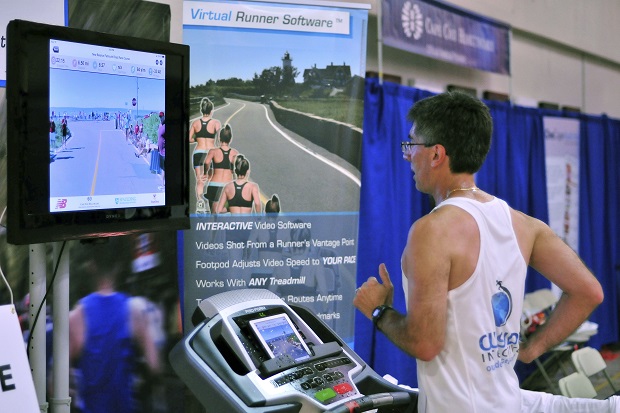
In this Thursday, Aug. 13, 2015 photo, Joe Ciavattone, an employee of Outside Interactive, demonstrates the company’s virtual race technology at the New Balance Falmouth Road Race expo in Falmouth, Mass. The company is partnering with the race to let runners compete on a treadmill virtually from anywhere while watching video footage of the actual 7-mile course. (Photo by Collin Binkley/AP)
FALMOUTH, Massachusetts — While thousands of runners descend upon Cape Cod for the New Balance Falmouth Road Race this weekend, an additional 100 are planning to compete from the comfort of their home or gym.
Whether they failed to snag a coveted bib or are serving overseas in the military, the displaced runners can grab a tablet computer, hop on the treadmill and take off while watching video of the actual course of Sunday’s race.
Falmouth is among the first races to let runners compete virtually from the treadmill, an idea that others are considering to widen their reach and boost their revenue.
The goal is to draw runners who can’t attend in the flesh. For Falmouth, that includes 3,000 runners who were turned away this year because of size limits, along with others who couldn’t travel to Cape Cod.
“This gives them an alternative to experience a little bit about what the race is all about,” said Dave McGillivray, director of the storied 7-mile race, now in its 43rd running.
Growing interest in the sport has pushed other US races to their capacities in recent years, while attracting technology companies that see a demand for virtual racing.
The company behind Falmouth’s virtual race, Outside Interactive, is unveiling its technology for the first time on Sunday. Treadmill competitors simply download an app to the tablet and are off and running.
Before now, the company specialized in creating videos that whisk runners away from the treadmill to scenic courses in Central Park or the sandy beaches of Puerto Rico.
“It’s never going to be fun, but we’re trying to make it engaging,” said Gary McNamee, founder and president of the company, which is based in Hopkinton, Massachusetts.
Another company, RunSocial, has announced plans to offer a virtual version of the London Marathon next year.
By casting a wider net, races can also tap into a new stream of revenue and attract new sponsors.
Virtual runners at Falmouth will pay $40, compared with $65 for the outdoor race. Those fees cover race costs only, McGillivray said, and anything leftover is donated to charity.
But the race’s sponsors will get extra exposure through advertisements that will be shown during the virtual race.
“It’s a 7-mile commercial,” McNamee said.
For their fee, treadmill runners will get an official finisher’s mug and a race keychain. Their times will be posted online but kept in a separate category from the outdoor race.
The price seemed fair to Jennifer Walker, who plans to race from a treadmill at her gym in Baltimore.
A former Boston resident, Walker has always wanted to run Falmouth. But with two young children and a husband who’s a physician, she said, traveling can be a challenge.
“This is so easy for me. All I have to do is pretty much do what I normally do — go run on the treadmill,” Walker said.
The video for Falmouth was filmed on a Segway about half an hour before the race started last year. It includes throngs of cheering fans along the course’s ocean vistas.
Outside Interactive has filmed 10 more races that could be developed into virtual versions, McNamee said.
Although the technology for virtual racing is relatively new, the idea isn’t.
For years, members of the military in far-flung locales have organized their own races to coincide with major events, such as the Chicago Marathon. In 2007, American astronaut Sunita Williams ran 26.2 miles on a space station’s treadmill during the Boston Marathon.
The technology from Outside Interactive borrows from that concept but tries to create an authentic simulation of the actual course.
When the video approaches a hill, for example, it prompts runners to increase the elevation on their treadmill. If runners want to pick up the pace, they increase the treadmill speed and then adjust a pace setting on the video, which can speed up or slow down.
McNamee hopes that in the future, advances in technology will make those adjustments easier.
As close as virtual running gets to the real thing, though, race directors predict it will always fall short.
“Truth be told, I don’t think you can compare the two,” said McGillivray, who is also director of the Boston Marathon. “It’ll never replace obviously the experience of running the race in person. Nothing will ever replace that. But it’s an alternative to that.”
As evidence, he only has to point to the grand prize for virtual runners: They’ll be entered into a lottery for a chance to run in-person next year.